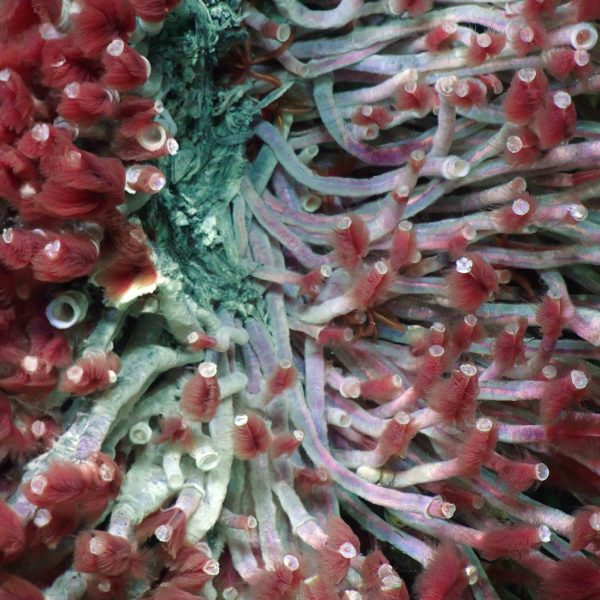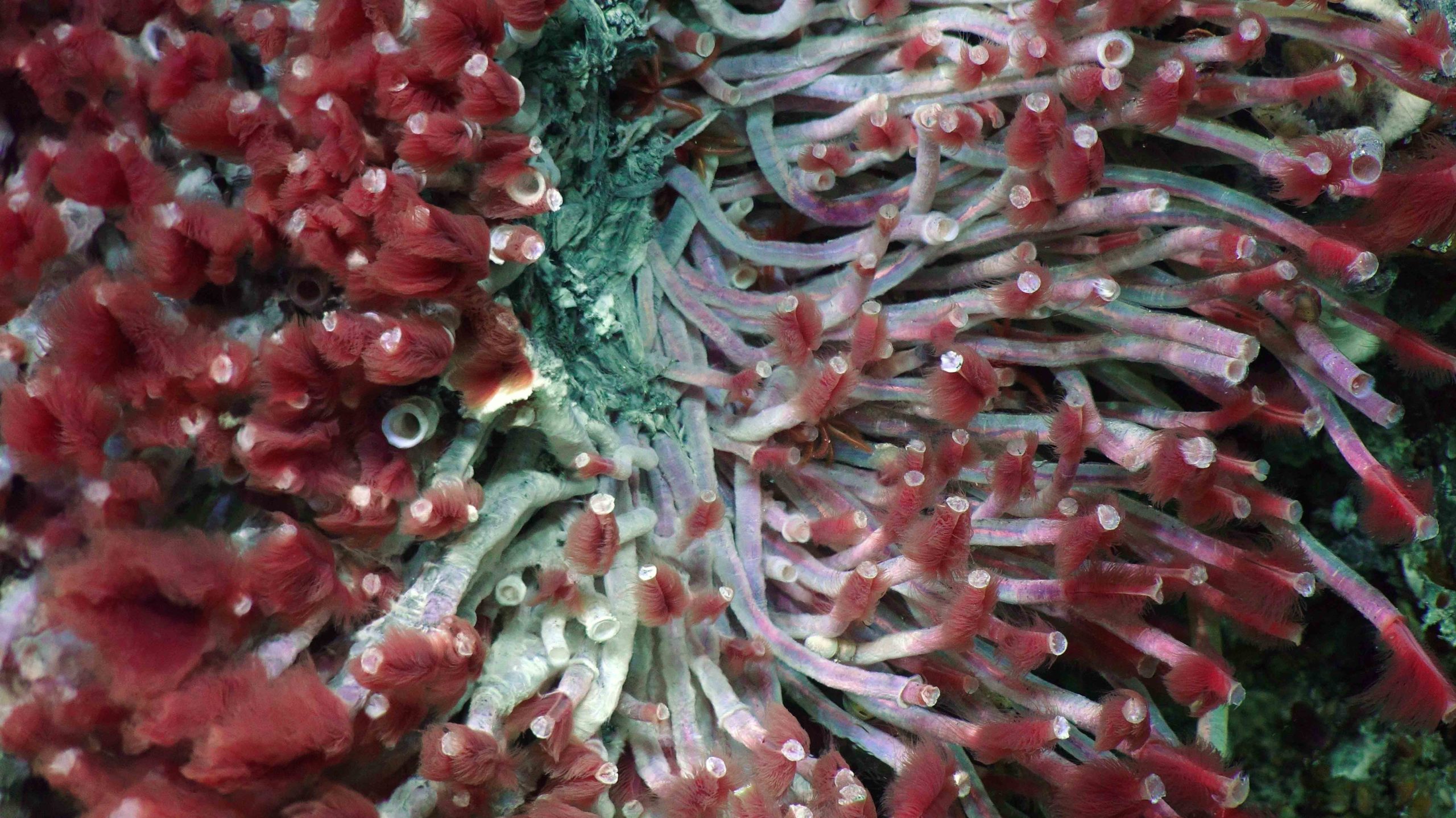Image Archive





























A rattail fish with a large parasitic copepod attached swims past a pink sea cucumber at Slope Base (2900 m). Credit: UW/NSF-OOI/WHOI, Dive J2-1159, V19

Scale worms crawling around some limpets on the side of a chimney at ASHES vent field in Axial Caldera. Credit: UW/NSF-OOI/WHOI, Dive J2-1197, V19

Ridgeia tube worms (left) and palm worms (right) on the side of a chimney at ASHES vent field in Axial Caldera. Credit: UW/NSF-OOI/WHOI, Dive J2-1197, V19

Ridgeia tube worms (left) and palm worms (right) on the side of a chimney at ASHES vent field in Axial Caldera. Credit: UW/NSF-OOI/WHOI, Dive J2-1197, V19

The bright red gill plumes of Ridgeia tube worms growing around a hydrothermal vent at ASHES in Axial Caldera. Credit: UW/NSF-OOI/WHOI, Dive J2-1197, V19

Red Ridgeia tube worm gills and white bacterial mats growing around a hydrothermal vent at ASHES in Axial Caldera. Credit: UW/NSF-OOI/WHOI, Dive J2-1197, V19

Ridgeia tube worm gill plumes contrast with the white bacterial mats growing around a hydrothermal vent at ASHES in Axial Caldera. Credit: UW/NSF-OOI/WHOI, Dive J2-1197, V19

Close-up of Ridgeia worm tubes and gill plumes at a hydrothermal vent at ASHES in Axial Caldera. Credit: UW/NSF-OOI/WHOI, Dive J2-1197, V19

sulis_20190706184521_ridgea_worms_small

A hydrothermal vent chimney at ASHES in Axial Caldera, covered with Ridgeia tube worms, palm worms, limpets, scale worms, and bacteria. Credit: UW/NSF-OOI/WHOI, Dive J2-1197, V19

Palm worms extending up the side of a hydrothermal vent chimney at ASHES in Axial Caldera. A scale worm and limpets are on the left side of the chimney. Credit: UW/NSF-OOI/WHOI, Dive J2-1197, V19

Scale worms crawling over filamentous bacterial mats and blue ciliates on the side of a hydrothermal vent chimney at ASHES in Axial Caldera. Credit: UW/NSF-OOI/WHOI, Dive J2-1197, V19

A Giant Blob Sculpin (Psychrolutes phrictus; ID from B. Frable, SIO) swam over to stare disapprovingly at our temperature probes prior to the thermistor survey at ASHES vent field on Axial Volcano (1540 m). Photo Credit: UW/NSF-OOI/WHOI, Dive J2-1196, V19

Filamentous bacteria and blue ciliates growing on the side of a hydrothermal vent chimney at ASHES in Axial Caldera. Credit: UW/NSF-OOI/WHOI, Dive J2-1197, V19

A deep-sea slime star (Hymenaster sp.) at 2900 meters depth, off the coast of Oregon. Photo credit: UW/NSF-OOI/WHOI, Dive J2-1182, V19

Flytrap Anemone (so-named for obvious reasons) attached to a glass sponge stalk at 2900 meters depth, off the coast of Oregon. Photo credit: UW/NSF-OOI/WHOI, Dive J2-1182, V19

A very large brisingid sea star (ID from C. Mah, Smithsonian), plus a white anemone attached to the OOI electro-optical cable. We saw a ton of these during the survey, at 2900 meters depth off the coast of Oregon. Photo credit: UW/NSF-OOI/WHOI, Dive J2-1182, V19

A brisingid starfish, orange anemone, and a soft-bodied echinothuriid sea urchin (the purple guy at bottom), clustered around a junction in the OOI electro-optical cable. 2900 meters depth, off the coast of Oregon. Photo credit: UW/NSF-OOI/WHOI, Dive J2-1182, V19

An eelpout (Pachycara sp. according to B. Frable, SIO) laying on the seafloor next to Primary Node PN1A at Slope Base in 2019. Photo credit: UW/NSF-OOI/WHOI, Dive J2-1182, V19

Pink sea anemones attached to the Slope Base Primary Node PN1A. Photo credit: UW/NSF-OOI/WHOI, Dive J2-1182, V19

A pudgy cusk eel (Spectrunculus grandis) swimming by a marker with flytrap anemones attached to it at Slope Base (2900 meters) in 2019. Credit: UW/NSF-OOI/WHOI, Dive J2-1182, V19

A side-on view of a dinner plate jelly in the water column above Southern Hydrate Ridge. Photo credit: UW/NSF-OOI/WHOI, Dive J2-1179, V19

Sea pen and brittle stars on the sediment at Southern Hydrate Ridge in 2019. Photo credit: UW/NSF-OOI/WHOI, Dive J2-1176, V19

A corallimorph sea anemone growing in a clam bed at Southern Hydrate Ridge in 2019. Photo credit: UW/NSF-OOI/WHOI, Dive J2-1172, V19

Pom-pom anemone, pink sea urchins, and brittle stars on the seafloor at the Oregon Offshore site (600m depth). Credit: UW/NSF-OOI/WHOI, Dive J2-1170, V19

Pom-pom anemone, pink sea urchin, and brittle stars on the seafloor at the Oregon Offshore site (600m depth). Credit: UW/NSF-OOI/WHOI, Dive J2-1170, V19

A wolf eel swimming past the Jason undervator at the Oregon Shelf (80 m) site in 2019. Credit: UW/NSF-OOI/WHOI, Dive J2-1162, V19

A sea cucumber (likely Paelopatides sp.) next to some cables at Slope Base. Credit: UW/NSF-OOI/WHOI, Dive J2-1160, V19
- Anemone
- Animal
- Arthropod
- ASHES
- Axial
- Axial Base
- Axial Biology
- Axial Caldera
- Bacteria
- Basalt Lava
- BEP
- Biofouling
- biolgoy
- Biology
- Camds
- Camera
- Camhd
- Central Caldera
- Ciliates
- Cnidaria
- Coastal Biology
- Crab
- Deep Profiler Mooring
- Dive Highlights
- Eastern Caldera
- Echinoderms
- Endurance Array
- Engineering Team
- ENLIGHTEN 10
- Exploratorium
- Fish
- Geology
- HD Camera
- HPIES
- Hydrate Ridge
- Hydrates
- Hydrophone
- Hydrothermal Vents
- Illustration
- Inshore 80 Meters
- Instrument
- International District
- J-BOX
- Jason
- Jellyfish
- Junction Box
- K12
- Lava
- Mollusk
- Moorings
- Nodes
- Nudibranch
- Octopus
- OOI
- Oregon Offshore
- Oregon Offshore 600 m
- Oregon Shelf
- Oregon Slope Base
- People
- PN1B
- PN1D
- Polychaetes
- PPSDN
- Primary Node
- RASFL
- ROCLS
- ROPOS
- ROPOS Dives
- ROV Team
- RV Revelle
- RV Sikuliaq
- RV Thompson
- Salp
- Sample
- SC13
- Science Team
- Sea Cucumber
- Sea Star
- Sea Urchin
- Seafloor
- Seismometer
- Sensors
- Shallow Profiler Mooring
- Shark
- Shipboard
- Shore Station
- Slope Base
- Smoker
- Soft Coral
- Southern Hydrate Ridge
- Sponge
- Squid
- Students
- Students & Guest Participants
- Tmpsf
- Tubeworms
- VISIONS 11 Leg 1
- VISIONS 11 Leg 2
- VISIONS 11 Viewers
- VISIONS 13
- VISIONS 14
- VISIONS 15
- VISIONS 16
- VISIONS 17
- VISIONS 18
- VISIONS 20
- VISIONS 22
- VISIONS 23
- Visualization
